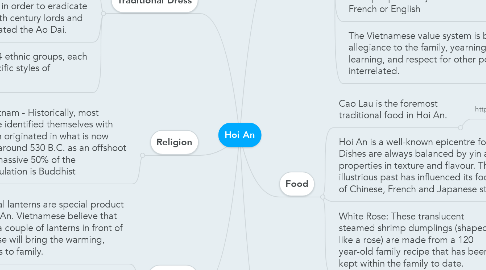
1. Culture
1.1. The town reflects a fusion of indigenous and foreign cultures (principally Chinese and Japanese with later European influences) that combined to produce this unique survival.
1.1.1. http://whc.unesco.org/en/list/948
1.2. Despite the economic shifts, Hoi An’s culture has remained strong creating a unique convergence of people, traditions, and philosophy.
1.2.1. http://www.ecotrust.org/hoi-an-vietnam-and-the-resilience-of-culture/
1.3. Vietnamese life is profoundly influenced by ancestor worship. Children learn at a very early age that they owe everything to their parents and their ancestors. Many languages and dialects are spoken in Vietnam, but Vietnamese is the official language and the language of most people. Many older Vietnamese are familiar with French or English
1.3.1. http://www.vietnam-culture.com/zones-6-1/Vietnamese-Culture-Values.aspx
1.4. The Vietnamese value system is based on four basic tenets: allegiance to the family, yearning for a good name, love of learning, and respect for other people. These tenets are closely interrelated.
2. Food
2.1. Cao Lau is the foremost traditional food in Hoi An.
2.1.1. http://hoian-tourism.com/local-guide/hot-news/top-7-local-foods
2.2. Hoi An is a well-known epicentre for foodies. Dishes are always balanced by yin and yang properties in texture and flavour. The town’s illustrious past has influenced its food with hints of Chinese, French and Japanese styles.
2.2.1. http://www.citypassguide.com/en/destination/hoi-an/food/vietnamese/hoi-an-specialities
2.3. White Rose: These translucent steamed shrimp dumplings (shaped like a rose) are made from a 120 year-old family recipe that has been kept within the family to date.
2.3.1. http://www.citypassguide.com/en/destination/hoi-an/food/vietnamese/hoi-an-specialities
3. Architecture
3.1. The town comprises a well-preserved complex of 1,107 timber frame buildings, with brick or wooden walls, which include architectural monuments, commercial and domestic vernacular structures, notably an open market and a ferry quay, and religious buildings such as pagodas and family cult houses.
3.1.1. http://whc.unesco.org/en/list/948
3.2. There is also the fine wooden Japanese bridge, with a pagoda on it, dating from the 18th century.
3.3. The surviving wooden structures and street plan are original and intact and together present a traditional townscape of the 17th and 18th centuries, the survival of which is unique in the region.
4. Traditional Dress
4.1. Conical Hat or Non La - According to ancient documents, the conical hat of Vietnam first appeared in Vietnam around the 13 century, during the Tran Dynasty.
4.1.1. http://www.vietnam-culture.com/zones-10-1/Vietnamese-Clothing.aspx
4.2. Ao Dai - With the intention of changing the way people dress in order to eradicate ancient habits, the 18th century lords and mandarins in Hue created the Ao Dai.
4.2.1. The traditional Ao Dai has become a topic for fashion designers to explore its beauty.
4.3. In Vietnam, there are 54 ethnic groups, each having unique and specific styles of clothing.
5. Religion
5.1. Buddhism in Vietnam - Historically, most Vietnamese have identified themselves with Buddhism, which originated in what is now southern Nepal around 530 B.C. as an offshoot of Hinduism. A massive 50% of the Vietnamese population is Buddhist
5.1.1. http://www.vietnam-culture.com/zones-16-1/Vietnamese-Religions.aspx
5.1.2. http://hoian-tourism.com/the-heritage/hoi_an_festival/buddhas-birthday-festival-2
6. Lanterns
6.1. Traditional lanterns are special product from Hoi An. Vietnamese believe that hanging a couple of lanterns in front of their house will bring the warming, happiness to family.
6.1.1. http://www.vietnamwiki.net/Hoi_An__My_Son-Shop-Hoi_An_lanterns-P187
6.2. The Hoi An Full Moon Festival is held on every 14th day of the lunar month at the World’s heritage ancient town in Central Vietnam. During these nights, Hoi An ancient town switches off its electric lights and shuts down to motorized vehicles and the lanterns go on (that’s why it is also called Hoi An Lantern Festival).
6.2.1. http://www.theworldfestival.net/hoi-an-lantern-festival.html
